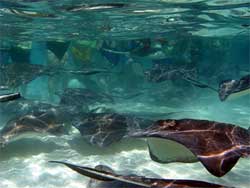 KINGSTON, R.I. – March 18, 2013 — Stingrays living in one of the world’s most famous and heavily visited ecotourism sites — Stingray City/Sandbar in the Cayman Islands — have profoundly changed their ways, raising questions about the impact of so-called “interactive ecotourism” on marine wildlife.
KINGSTON, R.I. – March 18, 2013 — Stingrays living in one of the world’s most famous and heavily visited ecotourism sites — Stingray City/Sandbar in the Cayman Islands — have profoundly changed their ways, raising questions about the impact of so-called “interactive ecotourism” on marine wildlife.
The study was published today in the journal PLOS ONE.
Researchers from the University of Rhode Island and Nova Southeastern University’s Guy Harvey Research Institute studied the southern stingray population at Stingray City — a sandbar in the Cayman Islands that draws nearly a million visitors each year to feed, pet and swim with its stingrays — to assess how the intensive ecotourism has affected the animals’ behavior.
“Human wildlife interactions are expanding all over the world, so it’s important to take pause and think about how these activities are affecting the biology of the animals,” said URI researcher Brad Wetherbee.
The researchers found that Stingray City’s stingrays show distinctly different patterns of activity than their wild counterparts, who don’t enjoy daily feedings or close human contact.
“We saw some very clear and very prominent behavioral changes, and were surprised by how these large animals had essentially become homebodies in a tiny area,” said study co-author Mahmood Shivji, a professor at the NSU Oceanographic Center and director of the Guy Harvey Research Institute.
Wild stingrays are active at night and solitary — they forage through the night over large distances to find food, and rarely cross paths with other stingrays. To see if Stingray City’s fed stingrays stray from this behavior, the research team tagged and monitored both wild and fed stingrays over the course of two years and compared their patterns of movement.
“A prominent change was that fed stingrays reversed their natural daily rhythms, becoming active during the day and resting at night — a complete contrast to their wild counterparts,” said Wetherbee.
They also didn’t mind rubbing shoulders with their neighbors: At least 164 stingrays abandoned the species’ normal solitary behavior, crowding together in less than a quarter square mile of space at Stingray City. They even formed schools and fed together. The fed stingrays mated and became pregnant year-round, instead of during a specific mating season, and also showed signs of unusual aggression, biting each other more frequently than their wild counterparts.
These results suggest that human-provided food can dramatically change how even large, highly mobile ocean animals behave — with potentially serious consequences. There are likely to be health costs that come with these behavior changes, which could be detrimental to the animals’ wellbeing in the long term, the researchers conclude.
Stingray City means big business in the Cayman Islands, where each stingray generates as much as $500,000 annually in tourism income. The research team plans to continue to monitor Stingray City’s population to track its health — and the industry’s impact — over time.
“Right now, these animals have no protection at all,” said study co-author Guy Harvey, who initiated the project. “Without more studies like these, we won’t know what that means for the wildlife or if we need to take action. It’s unclear how much of the stingray’s daily diet comes from tourism provided food, but the good news is we have seen the animals forage when tourists are absent suggesting that these animal are not completely dependent on these handouts.”
Photo submitted by Brad Wetherbee.

